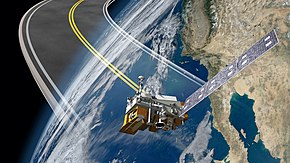 Artist illustration of the NOAA-20 satellite | |||||||||||||
| Names | JPSS-1 | ||||||||||||
|---|---|---|---|---|---|---|---|---|---|---|---|---|---|
| Mission type | Weather | ||||||||||||
| Operator | NOAA | ||||||||||||
| COSPAR ID | 2017-073A | ||||||||||||
| SATCAT no. | 43013 | ||||||||||||
| Website | http://www.jpss.noaa.gov/ | ||||||||||||
| Mission duration | 7 years (planned) [1] 6 years, 9 months, 16 days (elapsed) | ||||||||||||
| Spacecraft properties | |||||||||||||
| Spacecraft type | Joint Polar Satellite System-1 | ||||||||||||
| Bus | BCP-2000 | ||||||||||||
| Manufacturer | Ball Aerospace & Technologies | ||||||||||||
| Launch mass | 2540 kg | ||||||||||||
| Dry mass | 1929 kg | ||||||||||||
| Payload mass | 578 kg | ||||||||||||
| Dimensions | 1.3 m x 1.3 m x 4.2 m | ||||||||||||
| Power | 1932 watts | ||||||||||||
| Start of mission | |||||||||||||
| Launch date | 18 November 2017, 09:47:36 UTC | ||||||||||||
| Rocket | Delta II 7920-10C D-378 | ||||||||||||
| Launch site | Vandenberg, SLC-2W | ||||||||||||
| Contractor | United Launch Alliance | ||||||||||||
| Entered service | 30 May 2018 | ||||||||||||
| Orbital parameters | |||||||||||||
| Reference system | Geocentric orbit | ||||||||||||
| Regime | Sun-synchronous orbit | ||||||||||||
| Perigee altitude | 824.3 km (512.2 mi) | ||||||||||||
| Apogee altitude | 833.0 km (517.6 mi) | ||||||||||||
| Inclination | 98.79° | ||||||||||||
| Period | 101.44 minutes | ||||||||||||
| |||||||||||||
 JPSS-1 Mission Insignia Large Strategic Science Missions Earth Science Division | |||||||||||||
NOAA-20, designated JPSS-1 prior to launch, is the first of the United States National Oceanic and Atmospheric Administration's latest generation of U.S. polar-orbiting, non-geosynchronous, environmental satellites called the Joint Polar Satellite System. NOAA-20 was launched on 18 November 2017 and joined the Suomi National Polar-orbiting Partnership satellite in the same orbit. NOAA-20 operates about 50 minutes behind Suomi NPP, allowing important overlap in observational coverage. Circling the Earth from pole-to-pole, it crosses the equator about 14 times daily, providing full global coverage twice a day. This gives meteorologists information on "atmospheric temperature and moisture, clouds, sea-surface temperature, ocean color, sea ice cover, volcanic ash, and fire detection" so as to enhance weather forecasting including hurricane tracking, post-hurricane recovery by detailing storm damage and mapping of power outages.[2][3]
The project incorporates five instruments, and these are substantially upgraded since previous satellite equipment. The project's greater-detailed observations provide better predictions and emphasize climate behavior in cases like El Niño and La Niña.[2]
The satellite bus of the project and Ozone Mapping and Profiler Suite (OMPS) equipment, was designed by Ball Aerospace & Technologies. The Visible Infrared Imaging Radiometer Suite (VIIRS) and the Common Ground System (CGS) were built by Raytheon Company, and the Cross-track Infrared Sounder (CrIS) was by Harris Corporation. The Advanced Technology Microwave Sounder (ATMS) and the Clouds and the Earth's Radiant Energy System (CERES) instrument were built by Northrop Grumman Innovation Systems.[2]
- ^ Cite error: The named reference
MissAndInstwas invoked but never defined (see the help page). - ^ a b c Cite error: The named reference
launchwas invoked but never defined (see the help page). - ^ Russell, Kendall (27 October 2017). "Next-Gen Weather Satellite JPSS 1 Readies for Launch". Satellite Today. Retrieved 19 December 2017.
© MMXXIII Rich X Search. We shall prevail. All rights reserved. Rich X Search
